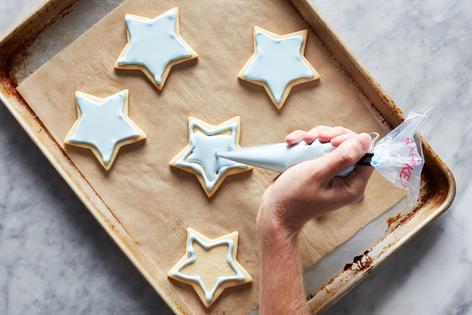The Kitchn: How to make royal icing for fuss-free cookie decorating
Every year as the holidays approach, I eagerly anticipate baking and decorating sugar cookies. And every year, they don’t exactly turn out as planned. That’s because decorating cookies is a lot easier said than done — especially if you’re a perfectionist like me who likes straight lines and clean edges.
But this year, I’m prepared. I got to work developing a simple royal icing recipe that makes cookie decorating as stress-free (and mess-free!) as possible. It’s easy to make (no meringue powder necessary!), and its super-smooth texture makes it the very best icing for picture-perfect cookies. Fuss-free cookie decorating is possible, and this recipe is the perfect place to start.
What’s the difference between royal icing and regular icing?
The biggest difference between royal icing and the type of icing you see drizzled over coffee cakes or spread onto cinnamon rolls is the texture. Royal icing dries into a hard, candy-like coating that crunches when you bite into it. It’s designed to harden so you can decorate on top of it with piped royal icing, or even paint it. If you’re looking for picture-perfect sugar cookies, royal icing is the way to go.
Royal icing ingredients
You only need three ingredients for this easy royal icing: egg whites, powdered sugar and any extracts or food colorings you like. I recommend using conventional powdered sugar rather than organic, which can give the icing an unwanted gray color. We’ve opted for egg whites rather than meringue powder (which you may see in other recipes) since meringue powder can be hard to source.
We’ve also included measurements for using pasteurized liquid egg whites in our recipe. These are the egg whites that come in the carton near the shell eggs. They’re a bit easier to work with and will save you from having to separate your eggs.
Piping and flooding sugar cookies
When you’re ready to decorate, you’ll want to split the icing into two bowls: one for piping and one for flooding. It’s important to note that royal icing dries out very quickly and forms a crusty skin if left uncovered, so make sure to cover it anytime you’re not working with it. If the surface does dry out, discard any dry pieces and give the icing a good mix to rehydrate it.
Piping icing: Piping icing is what you’ll use to pipe borders around the cookies. It should be relatively thick — like toothpaste. If you make the recipe as is, you should have the right consistency for piping.
Flooding icing: This icing is used to fill the piped border of icing with loose frosting that evenly “floods” from edge to edge. This icing should be the consistency of honey: pourable yet still relatively thick. The best way to achieve this is to add a few tablespoons of water. We recommend adding one tablespoon at a time — stirring between each addition — until your desired consistency is achieved. You can always add more water, but you can’t take it away, so go slow and don’t rush it. If there are any air bubbles on the surface of your icing, use a toothpick to pop them.
How long does royal icing take to dry?
While it might be tempting to stack your beautifully decorated cookies on a festive plate, rushing to do so will cause them to smear. Give your cookies at least four hours to dry before attempting to move them.
How to Make Royal Icing
Makes 3 cups
3 1/2 cups powdered sugar (1 pound), plus more as needed
4 large pasteurized egg whites, or 1/2 cup liquid egg whites
1 teaspoon extract of choice, such as vanilla or lemon (optional)
Food coloring (optional)
Water, as needed
1. Sift the powdered sugar. Sift 3 1/2 cups (1 pound) powdered sugar through a fine-mesh strainer into a large bowl. If any lumps are left in the strainer, use your fingers to break them up and push them through the strainer.
2. Measure the egg whites. Place 4 large pasteurized egg whites or 1/2 cup liquid egg whites in the bowl of a stand mixer fitted with a whisk attachment. (Alternatively, use an electric hand mixer and large bowl.)
3. Whip the egg whites until foamy. Whip on medium-high speed until foamy, doubled in volume, and opaque, about 2 minutes.
4. Beat in the powdered sugar. Turn the mixer off and add half of the powdered sugar. Mix on low speed until the powdered sugar is completely dissolved and no large lumps remain, 1 to 2 minutes. Add the remaining powdered sugar and continue mixing until completely dissolved, 1 to 2 minutes more.
5. Whip until smooth and glossy. Increase the mixer speed to high and whip until the icing is completely smooth, glossy, and slightly thickened, 4 to 5 minutes. The icing should hold a soft peak and slowly run off of the whisk attachment. If the icing is too loose, add more powdered sugar, 1/4 cup at a time, and continue mixing until completely incorporated.
6. Add optional extracts and food coloring. Decrease the mixer speed to low and add 1 teaspoon extract and a few drops of food coloring, if desired. Mix until the icing is smooth and evenly colored, 1 to 2 minutes.
7. Adjust the consistency with water. The icing can be used as-is or thinned out with water to achieve a pourable consistency for flooding cookies. Add water in 1 teaspoon increments, stirring between each, until desired consistency is reached. If not using immediately, press a sheet of plastic wrap directly on the surface of the frosting to keep it from drying out until ready to use.
8. Decorate cookies with the icing and let dry. Decorate cookies with the icing and let completely dry before touching them, at least 4 hours.
Recipe notes
Royal icing can be refrigerated in an airtight container with a sheet of plastic wrap pressed directly onto the surface for up to one week. When ready to use, adjust the consistency as needed with water.
Consuming raw egg whites will always come with some inherent risks. That’s why we recommend using pasteurized eggs, which are gently heated, to reduce the risk of food-borne illnesses. All egg products in the United States are pasteurized as required by the USDA — so you’re good to go as long as you stick to eggs from the grocery store (don’t use ones that come straight from the farm).
(Jesse Szewczyk is studio food editor for TheKitchn.com, a nationally known blog for people who love food and home cooking. Submit any comments or questions to editorial@thekitchn.com.)
©2020 Apartment Therapy. Distributed by Tribune Content Agency, LLC.







